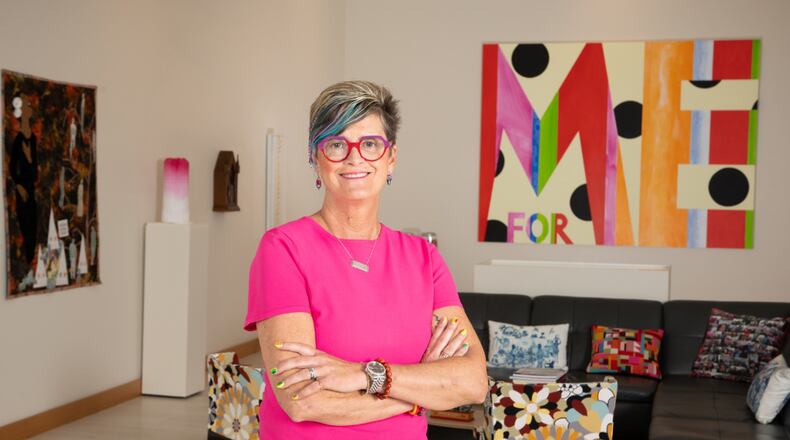The new exhibit, open through Sept. 8, is indeed ... riveting. It addresses a variety of current topics with a wide range of art media: painting, sculpture, drawing, printmaking and performance art. It’s packed with controversy and intrigue.
The exhibition, curated by head curator Jerry Smith and photography curator Mariah Portlewait, includes more than 85 artworks by 79 artists and it all represents one person’s love affair with art.
We chatted with Sara Vance Waddell, a Cincinnatian who owns the pieces on display now.
Did you grow up with artists or in a family that exposed you to the arts?
I grew up in a small town and was never exposed to art. My mother had some John Ruthven works but they didn’t interest me. I went into my first art museum when I was in my late 30s.
I’m in the field of media planning and when the Cincinnati Art Museum became my client for advertising I found myself going there for meetings and would look around. It was something I’d never thought about and I was overwhelmed by the beautiful art. It was mind blowing.
The art bug hit me hard. I started collecting and being philanthropic in the arts.
What were some of your earliest purchases?
A painting by Elizabeth Nourse was something I bought early on. It’s in the DAI exhibit. I knew Elizabeth Nourse was from Cincinnati and I wanted a work by her. I loved the mother and child as it reminded me of my mother and me. (The watercolor painting, which dates back to 1891, is entitled “Borst Interior” and shows a mother reading with her child. Nourse, a portrait and landscape painter, was from Mt. Healthy.)
I collected what I liked and enjoyed the hunt of finding and acquiring the work. I didn’t know where that was going to take me. There were a lot of white male artists in my collection early on. One day I was in Aspen skiing and I walked into a gallery and they carried Chagall. I collected Chagal, Picasso and Matisse.
I buy art because I enjoy the whole process. I don’t buy it to sell it.
How and why did your focus change over the years?
As I started collecting more, I started researching more and reading about artists. I joined the boards of the Cincinnati Art Museum and the Contemporary Art Center in Cincinnati and found my passion. I made a switch and my focus completely changed to all contemporary living artists. I enjoy getting in touch with the artists, meeting them and getting to know them. I want to know what motivated them to do a particular piece. And honestly now a lot of my friends are artists and these have become lovely relationships.
I like politically charged art that makes a statement and art that talks about uncomfortable situations.
For the past 12 years I have collected art by women and artists of color. That’s because, still to this day, women artists and artists of color do not garner the same respect as the male artists do. I thought I would try to correct that situation the way I could. I have no plans to stop collecting and I am even more focused today in lifting up women artists and giving them a voice.
I love to entertain, and a lot of our friends love coming over to see what I’ve collected lately. Not everyone loves all of my art, not even my wife, Michelle. The work she doesn’t want to see or like either goes in my gallery or my office. I choose the work she’s OK with for the common areas.
How did the current exhibit come about?
I first met Jerry when he borrowed some of my artwork for another exhibit. I really loved to hear a male curator say he’d like to do an exhibit of work by women artists. So this exhibit has been in the works for a few years. This is the first time such a big chunk of the work has been out of my home. A lot of it has never been exhibited before.
The artwork has mainly been up in our house and our place in New York. I miss some of it now: the horse isn’t where it usually is; the bench we sit on is gone. (The horse is a bronze sculpture entitled “Mare’s Nest” by artist Deborah Butterfield who makes sculptures from found items such as driftwood. The white marble bench by Jenny Holzer is called “Survival Series: It is in your self interest to find a way to be very tender.”)
The majority of the work in the DAI show is by living artists, maybe 20 percent are deceased. All of them were living at the time I collected them.
Can you talk about a couple of your favorite pieces?
That’s like being asked to pick a favorite child. But if I had to pick one or two I’d choose Patricia Cronin’s “Memorial to a Marriage.” Both she and her wife, Deborah Kass, are artists and this sculpture shows the two of them in a loving embrace. Patti did the sculpture 20 years ago before gay marriage was legal. They’d bought a burial plot in Brooklyn and the life-size marble sculpture will be their resting place some day. Patti’s thought was that what she and Deb couldn’t do in life — have a marriage — they would have in death. It’s a work that has always spoken to me and is a really important piece I’ve always loved owning.
The piece in the DAI exhibit is a bronze edition of the larger-than-life sized marble statue.
I’d also pick “Shark Girl as Boxer.” I took up boxing years ago for fitness and still do it today. A local artist, Casey Reardon, started making these shark girl images in different pieces of art — paintings, drawings. She was afraid of sharks as a child. She had a fear of them being in the swimming pool and so she made these sharks to combat her childhood fear.
Everyone in Cincinnati knows about shark girl and she’s everyone’s favorite. There’s a sculpture of her at the Contemporary Arts Center.
I reached out to Casey to do a commission. I was envisioning a shark girl with pink boxing gloves like mine. But when you give an artist a commission you need to let them go with it, and this artist did something very different.
She did a lot of research and found out that the very first women boxers were in England in the 1800s. Women would fight in the streets barehanded in their dresses and pumps. So this shark girl is wearing apparel that matches styles popular around the 1760s and if you look at her knuckles they’re beat up and one of her teeth is chipped and she has a black eye. That’s what I love about artists: they are so creative and have interesting minds.
I was blown away when I came to the opening at the DAI and saw the museum had put a shark girl in a boxing ring in the lobby.
One of the most shocking pieces of art in the exhibit and one people will be talking about is Carolee Schneemann’s “Interior Scroll.” Why did you want to include it in your collection?
It’s an important piece of art by a pioneer feminist artist. What Carolee was doing in the early 70s was taking a stab at white male artists; she wanted the world to know the art world was still male-dominated. It was an in-person performance where she stood on a table, disrobed and read her poem, “I Met a Happy Man” which was typed on a long, narrow strip of paper that she slowly pulled [out of her body]. No one else has her original drawings that are on display at the DAI.
What do you hope people will take away from seeing your exhibit?
I hope people will take away many emotions. I want them to see work that makes them smile and brightens their day. I also want the exhibit to be thought-provoking. I want them to think about the difficult decisions women are facing today such as reproductive rights. When a woman’s rights are taken away, it has a negative effect on them; I want them to think what that would be like for their daughter. I don’t care if they agree or not, I just want them to think about it.
A lot of people assume you have to have to be wealthy to become an art collector?
Art is not just for the wealthy. Anyone who has the bug to collect can acquire art on any budget. If you acquire art by emerging artists and art grad students the prices are very reasonable since they haven’t been established yet.
Please support local artists. I have a lot of art from national and international artists but I also collect local artists and I requested that a big portion of the art in the DAI exhibit be local artists, emerging artists, I have bought several pieces from women still in art school who hadn’t yet graduated when I bought their work.
It’s never too late to get interested in art and collect art. My advice is to collect what you like; do not focus on anyone else’s opinion. Do what makes you happy.
How to go
What: “Riveting: Women Artists from the Sara M. and Michelle Vance Waddell Collection”
Where: Dayton Art Institute, 456 Belmonte Park N, Dayton
When: 11 a.m.to 5 p.m. Wednesday; 11 a.m. to 8 p.m. Thursday; 11 a.m. to 5 p.m. Friday-Saturday and noon to 5 p.m. Sunday
Admission: $15 adults; $10 seniors (60+), active military and groups (10 or more); $5 students (18+ w/ID) and youth (ages 7–17); and free for children (ages 6 & younger)
Please note: This exhibition has images of nudity and art addressing social issues that include sexual relations, reproductive rights and violence. It also includes one artwork with moving and flashing LED lights.
More: daytonartinstitute.org/visit or 937-223-4278
Related programming:
- Community Guided Tour: 6-7 p.m. Thursday, July 25, and from 1-2 p.m. Aug. 10
- Create with a Creator: 1-4 p.m. Aug. 25, $100 for members and $125 for non-members
About the Author






